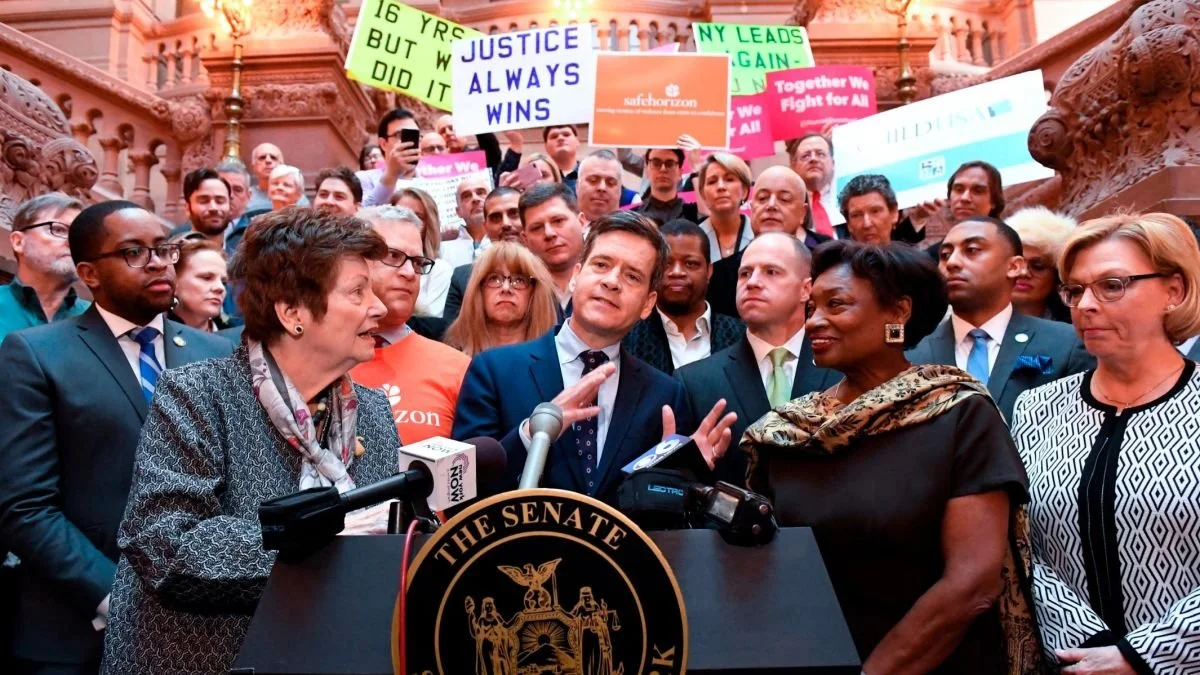WHAT IS A STATUTE OF LIMITATIONS WINDOW?
A statute of limitations window is a period of time during which civil cases that were previously barred from being filed in court because they had passed the statute of limitations are revived and can be brought in court. In many states these statute of limitations windows are fully retroactive, meaning regardless of one’s age, or how long ago they were abused, they can file a civil suit against their abusers and any person or institution who enabled it.
what is a statute of limitations?
A statute of limitations is a law which sets the maximum time in which parties involved have to initiate legal proceedings from the date of an alleged offense, whether civil or criminal. Each state has a different statute of limitations for child sexual abuse. To look up the current statute of limitations in your state, click here to see a list of statutes of limitations by state on Child USA’s site.
Before the child victims act passed, what was the statute of limitations for child sexual abuse in New York State?
New York is one example of a state that extended their statutes of limitations prospectively and opened a statute of limitations window. Before the Child Victims Act passed, survivors of child sexual abuse, generally speaking, had until the age of 23 to either press charges against their abusers, or file a civil lawsuit against their abusers and any individuals or institutions that enabled or covered up the abuse.
That means that under the old laws, generally speaking, once a survivor of child sexual abuse turned 23 years old they could no longer seek justice against their abusers or any individuals or institutions that enabled or covered it up.
how did the child victims act change those laws?
The Child Victims Act had three main provisions:
It extended the criminal statute of limitations to age 25 for misdemeanors and age 28 for felonies.
It extended the civil statute of limitations to age 55
It removed the 90 day notice of claim requirement for filing a civil case for sexual abuse against a public institution like a public school.
It opened a one-year window, starting August 14th 2019 and ending August 13th 2020, during which any old cases whose statutes of limitations had already expired are revived and can be brought again in civil court. The window was extended and closed on August 14th, 2021.
What is the difference between a criminal case and a civil case?
A criminal case is a case brought by the state against someone who committed a crime. The accused is held accountable by the state, and if found guilty can face jail time or other denials of their liberties. Because the penalties involve denials of liberties, the burden of proof is very high—beyond a reasonable doubt.
A civil case is where the perpetrator or any other responsible parties are held responsible directly by the victim, and must make reparation directly to the victim. If found guilty in a civil trial, a defendant would have to pay the victim for the damage caused, and can also be subject to other non-monetary conditions. Because the penalties are monetary and don’t involve the denial of any liberties, the burden of proof is lower than in criminal cases—to a preponderance of the evidence.
What is the Adult Survivors Act?
Modeled after the Child Victims Act, the Adult Survivors Act opens a one-year lookback window during which any case of sexual violence against an adult previously barred by the statute of limitations is revived and can be brought in civil court against the abuser or any individuals or institutions that enabled the abuse. The Adult Survivors Act was signed into law in New York State on May 24th 2022. The window will open 6 months later on November 24th, 2022, and closed on November 23rd, 2023.
Which states currently have statute of limitations windows open?
Before we answer that question, we just want to make sure you understand that if you’re considering pursuing either a criminal or civil case against your abuser, you should always consult a lawyer about your legal options. While we will try to give answers as thoroughly as possible, each case is different, and a lawyer can better personalize their advice to your specific situation. Each state will have its own particular statutes of limitations, and each law will have its own unique set of exceptions. If you see that the statute of limitations has expired in your state, or that the window closed, you should still seek the advice of a lawyer. It may be possible to file a case nonetheless.
Arkansas: Window opening on February 1, 2021 and closing on January 31, 2024. Civil suits can be filed against all defendants and is fully retroactive with no time limitations.
California: Window open permanently for plaintiffs up to age 40. For everyone else there was a window that opened on January 1, 2020 and will close on December 31, 2022. Up to age 40, or during the window period, civil suits can be filed against all defendants and is fully retroactive with no time limitations.
Colorado: 3-year window for claims against perpetrators, private organizations, and government for abuse that occurred between 1960 & 2021 opened on January 1, 2022 and will close on December 31, 2024. There are limits on what kinds of suits can be filed during this window.
Connecticut: There is a permanent retroactive revival window open in Connecticut for any case until the victim reaches age 48.
Guam: There is a permanent retroactive window open in Guam. There is no statute of limitations either prospectively or retrospectively on child sexual abuse in Guam.
Kentucky: There is a permanent retroactive window open in Kentucky for 5 years following the expiration of the statute of limitations in any case of child sexual abuse. Kentucky has a more complicated statute of limitations, and a lawyer should always be consulted for any cases in Kentucky.
Louisiana: A retroactive window opened on August 1, 2021 and will close on July 31, 2024. Civil suits can be filed against all defendants and is fully retroactive with no time limitations.
Maine: There is a permanent retroactive window open in Maine.
Maryland: There is a permanent retroactive window open in Maryland for any kind of child sexual abuse.
Massachusetts: There is a permanent retroactive window open in Massachusetts until the victim reaches age 53. This window only applies to civil suits filed directly against the abuser, and doesn’t include any third parties.
Nevada: There is a permanent window open in Nevada for suits filed against the perpetrator of the abuse. For suits against any third parties, including people or institutions who through negligence or failure to report enabled the abuse, there is a permanent window open until the victim reaches age 38.
Northern Mariana Islands: There is a permanent window open for all types of civil suits.
Vermont: There is a permanent window open for all types of civil suits.
What if my statute of limitations passed, or the statute of limitations window in my state closed? Is there any way for me to still get justice?
Statute of limitations laws can be very complicated and vary by state. Each state may have its own exceptions to the statutes of limitations. There may also be offenses that have no statute of limitations, or have specific statute of limitations extensions, or have provisions extending the statute of limitations depending on the specific circumstances of what you experienced. It’s always worth contacting a lawyer to be advised of your legal rights.
are there any forms of child sexual abuse for which there is no statute of limitations?
Yes, there are exceptions to the rule. Different states may have certain top-level offenses that don’t have statutes of limitations. That’s why it’s crucial that you always consult a lawyer to get specific advice regarding your legal options in your specific case.
how can I find a lawyer to advise me on my rights under the child victims act?
If you contact us we can put you in touch with an attorney who can best advise you.
why was the child victims act necessary?
On average, it takes survivors of child sexual abuse until the age of 52 to disclose their abuse. The majority of survivors will never disclose or report their abuse. Many states previously had statutes of limitations that didn’t acknowledge the reality of survivors’ experiences and had statutes of limitations that effectively prevented most survivors from ever having the opportunity to seek justice.
Child sexual abuse is unlike most other crimes in that by its very nature it prevents its survivors from reporting it until much later. More and more states are recognizing that while statutes of limitations in general are important for the criminal and civil justice systems generally, they don’t reflect the lived experiences of survivors, and are enacting laws to both fix the problem prospectively, and provide access to justice retroactively for survivors who were previously barred from seeking it.


